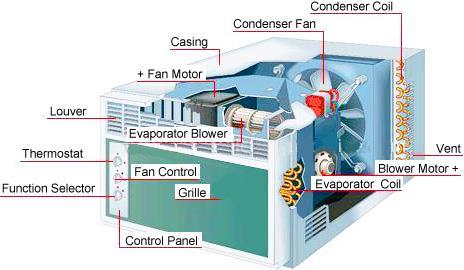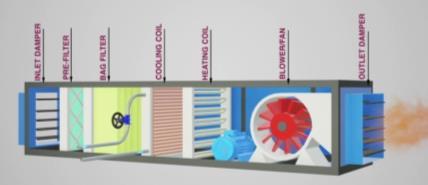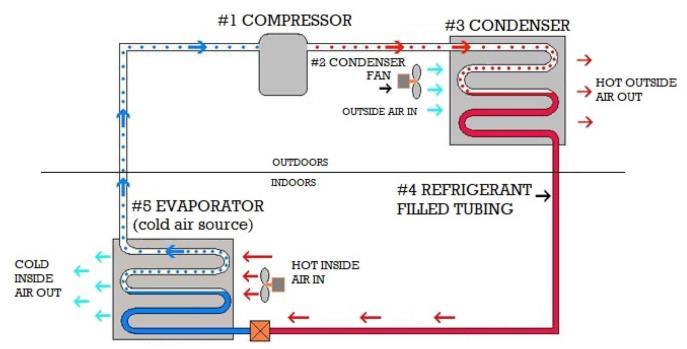
International Research Journal of Engineering and Technology (IRJET) e-ISSN: 2395-0056
Volume: 12 Issue: 01 | Jan 2025 www.irjet.net p-ISSN: 2395-0072


International Research Journal of Engineering and Technology (IRJET) e-ISSN: 2395-0056
Volume: 12 Issue: 01 | Jan 2025 www.irjet.net p-ISSN: 2395-0072
Ritik Singh Rawat1 , Ankit Goyal1 , Priyavrat Kumar1
1Department of Mechanical Engineering, Technocrats Institute of Technology and Science Anand Nagar, BHEL Opposite Hathaikheda Dam, Bhopal, Madhya Pradesh 462021 ***
Abstract - HVAC (heating, ventilation, and air conditioning) systems are essential for maintaining comfort and good indoor air qualityinavarietyof environments,includinghomes andbusinesses. The HVAC industry is changing toward smart, sustainable, and energy-efficient solutions as a result of growing environmental concerns and technical advancements. With an emphasis on smart technology, energy-efficient designs, theincorporationof renewable energy sources, and advancements in air quality control, this article explores contemporary trends in HVAC. It also discusses the difficulties the industry faces and suggests possible avenues for further research.
Key Words: HVAC (Heating, Ventilation, and AirConditioning),controllableenvironments.
ModelsofHVACsystemsevaluatetheelectrical,heating,and coolingenergyneedsoftheirconstituentpartsusingmass andenergyconservationconcepts.Thesethreeprocessesare combined in an HVAC system, which stands for heating, ventilation, and air conditioning [1–3]. It controls a building's ventilation, humidity, and quality. Room Temperature:Measuringdevicesthatadapttotheneedsof passengers are used to maintain the temperature in the passenger compartment [3]. Humidity:Tokeeppassengerscomfortable,theHVACsystem regulates humidity levels [4]. Air Purification: The technology filterstheair to get rid ofdust and bacteria to improve passenger comfort. A key concept since the introductionofHVACsystemsis"thermalcomfort,"which ASHRAEdefinesasasenseofcontentmentwiththethermal environment. This comfort affects HVAC efficiency and is essentialforhealth.AccordingtoBoyle's1660sresearch,the averagehumanbodytemperatureis37degreesCelsius,with onlyafewexceptions.Excessbodyheatmustbereleasedvia the skin to maintain a metabolic rate of 1 W/kg; during physical exercise, this rate can rise to 5 W/kg. This is equivalent to about 100 W during working hours for an average adult. When skin temperatures drop below 33 degreesCelsius,thebodylosesheatdependingonanumber ofexternalconditions[5].
Airtemperatureisacrucialindicatorofthermalcomfort,but in order to properly evaluate heat stress, it must be consideredinconjunctionwithothervariables.Inorderto ensureatleast80%occupantcomfort,currentstandardslike
ASHRAE55-2004andISO7730specifya"comfortzone"that takesinto account both personal characteristics(clothing, activity level) and thermal components (radiant temperature, humidity, air temperature, and air velocity). Participants in controlled laboratory tests evaluated their levelofcomfortunderstaticconditions,whichservedasthe basisforthesestandards.Additionally,theysetlimitsonthe temperature differential between the neck and ankles; according to ASHRAE 55-2004, this difference cannot be greaterthan5.4degreesFahrenheit[6].
The impact of different levels of thermal sensitivity on adaptive comfort models was investigated by Rupp et al. (2022)usinginformationfromthe"ASHRAEGlobalThermal ComfortDatabaseII."Theyusedfiveessentialstepsintheir methodology:i)takingapertinentsubsetoutofDatabaseII; ii) estimating the neutral temperature using conventional techniques.
Griffiths' method consisted of the following steps: iii) iteratingeachstepwithnewthermalsensitivitysettings;iv) creating adaptive comfort models for both naturally ventilatedandair-conditionedworkplacesusingdatafrom Europeandtheworld;andv)assessingthedifferentmodels created. The findings suggest that the temperature sensitivity of building occupants is influenced by various ventilation methods. In particular, office employees in naturally ventilated spaces were less sensitive to temperature fluctuations than those in climate-controlled spaces.Oneimportantconclusionisthatgeographiclocation and thermal sensitivity have a substantial impact on the "adaptive model relationship" between outdoor temperatures and inside neutral temperatures, with European occupants showing more sensitivity to temperature changes than those in other countries. Given thatadaptivecomfortstandardsarebasedontheadaptive model connection, this realization has significant ramifications for the planning and administration of naturallyventilatedandmixed-modebuildings.
Aspartoftheirinvestigation,[10]lookedatamulti-person workplacewithair-coolingequipmentinGuangzhou,China. Researchers looked into the relationship between gender and different environmental variables and how these affectedusers'propensitytoengageinadaptivebehaviors. Usinglogisticregression,aprobabilisticpredictionstudyof

International Research Journal of Engineering and Technology (IRJET) e-ISSN: 2395-0056
Volume: 12 Issue: 01 | Jan 2025 www.irjet.net p-ISSN: 2395-0072
behavioraladaptationstotemperatureextremeswascarried out.Usersonlyaccepteda1-degreeCelsiusincreaseoverthe neutral interior temperature in the study's hot climate. Whenconsumersadjusted,theinsidetemperaturefeltabout 1 degree Celsius higher in hotter weather and lower in colderweather,accordingtothethermalsensesurvey.The probabilityofadaptivebehaviorwasstronglyimpactedby bothindoorandoutdoortemperatures(P<0.005).Overall, theaccuracyoftheregressionanalysiswasover70%.The "adaptiveprobabilistic predictionmodel" forcoldandhot behaviorswasdevelopedusingthefindingsthatthecrucial temperatures for interior thermal contentment and dissatisfaction were 26°C and 28°C, respectively. Interestingly,hotadaptationbehaviorswerefirstobserved inmalesatabout22°C,about3°Cbelowthetemperatureat whichfemalesbegantoadjust.
[11]Researchontheflowpatternsandlosscharacteristics relatedtorectangularexpansionshasbeenpromptedbythe widespread usage of rectangular air ducts in ventilation systems. Initially, semi-empirical techniques were used to analyzetheBorda-Carnotlossundertheassumptionthatthe inletvelocityprofileswereconstantandcompletelyformed. Accordingtothestudy,traditionallossformulasthatrelyon uniforminflowhaveatendencytounderestimatelosses;in thecaseofeachrapidexpansion,theerrorscanreach3%.In thestudy'ssecondphase,thepreciseflowbehaviorandloss characteristicsinasquare-to-squarerapidexpansionwith an area ratio of 2.78 were experimentally analyzed. The Reynolds number range that was the focus of the investigation was 0.36×1050.36×105 to 1.8×1051.8×105, which is normal for ventilation systems. Accurate observationsofwindspeedsandturbulencewereobtained usinglaserDoppleranemometry.Thefindingsdemonstrated that the downstream consequences of a square-to-square expansion are much more extensive than those of an axisymmetricexpansion,withafullflowdevelopmentpath thatis1.5to2timeslongerandaflowreattachmentlength thatis1.5to2.5timeslonger[12].
Temporary, asymmetric sun radiation and uneven air temperature were identified as major elements in a study that looked at how people perceive temperature in cars compared to their experiences in homes and offices. 24 participantsand62trialsinthreedistinctoutdoordriving settingswereincludedinthestudy.Accordingtothestudy, therearetwoprimaryreasonswhypeopleperceivedifferent temperatures: 1) notable climate variations between summer cooling and winter heating, and 2) sudden variationsinsunradiationduringtransitionalseasons.Four modelsoftemperaturefeelingwereexaminedandcompared with the data: the transitory outdoor thermal sensation model,thedynamicthermalsensationmodelfromBerkeley, theUniversityofCaliforniamodel,andtheprojectedmean vote model. According to the findings, none of the models couldpredictwithanydegreeofaccuracyhowpassengers would feel about the temperature while driving. This
disparity was largely caused by the driver's exposure to abruptvariationsinthesun'sangle.Thestudythuscreateda novelthermalsensationmodelthattakesintoconsideration variations in the driver's thermal burden brought on by abrupt variations in sun radiation. A dynamic, fluctuating temperatureenvironmentwithinautomobileswasthenused toassessthenewmodel'sdependability[13].
OnthedeparturelevelofalargeairportterminalinChina, research looked at the patterns of passenger and service counter activity. To examine passenger flow patterns, the researchersemployedagent-basedsimulationthatincluded survey data. The findings demonstrated that the design occupant density in each sector closely matched the real situation at the airport, with only 3.6% of the simulated occupant density exceeding the design density. Due to changesintheallocationof passengersbytimeandplace, the maximum occupancy on the departure floor varied between 54.8% and 64.4%. The results indicate that by modifyingthequantityofmechanicalexternalairaccording to real occupancy rates, airport HVAC systems have a substantialchancetolowerenergyusage.Inparticular,the mechanical outdoor air's "maximum actual demand" for cooling load was only 25 W/m², as opposed to the design figureof47W/m².[14]
Inafour-personelectricautomobile,astudywascarriedout inbothwinterandsummer.Thetemperaturesoftheinside air and surface, along with the heat fluxes on different surfaces, were measured during the heating and cooling stages.Furthermore,ittooklongertoreachtheidealinterior temperature when the vehicle was moving because more heat was transported from the outside to the inside by convectionattheexteriorofthecabin[15].
Anumericalmodelwascreatedinresearch[16]toestimate airflowinapassengerbuscompartmentduringthesummer, and the correctness of the model was verified using experimentalmeasurements.Inthebus'scabin,theheating, ventilation, and air conditioning (HVAC) system caused a great deal of turbulence. The simulations comprised both seated and reclined manikins, which were used as heat sources.TheturbulentairflowwassimulatedusingtheV2f turbulencemodel.Bothwithandwithoutthemanikins,the degreeofcomfortinthecompartmentwasevaluatedattwo distincttemperaturesandairspeeds.Theshapeofthebox was also altered to make the manikins more comfortable. Theresultsshowedthatpassengersexperienceddiscomfort due to inconsistent temperatures caused by an inefficient layout. Better thermal conditions for both seated and sleepingpassengersresultedfromaredesignthatmadethe airflowmoresymmetrical.
[17] Asaresult,improvingsystemefficiencymaybecrucial toadvancingenvironmentalpreservationandsustainability. By describing the temperature and performance characteristics of VACR systems utilized in the food transportationindustryunderreal-timesettings,thestudy

International Research Journal of Engineering and Technology (IRJET) e-ISSN: 2395-0056
Volume: 12 Issue: 01 | Jan 2025 www.irjet.net p-ISSN: 2395-0072
fills a vacuum in the literature. Field data gathered from refrigeratedservicevehiclesthroughouttheyearwasused tocalculatedutycycles.FixedA/C-Rsystemsprovidedthe initialdata,whichwassubsequentlymovedtomobileVACR units for additional analysis. For more thorough testing, a test bed was also established at the LAEC. Mathematical models of the steady-state and transient thermal performance and properties of VACR systems were developed.Thesemodelswerethenvalidatedusingfieldand labdatatodoathoroughexaminationoftheVACRsystems' thermalperformance.
BymodelingthecreationandoptimizationofHVAC(heating, ventilation, and air conditioning) systems in passenger trains, a study emphasizes the growing significance of enhancing product quality and energy efficiency. It is still difficult to get the information regarding real working conditions, though. The study offers techniques for describing common HVAC conditions in trains in order to address this. First, Monte-Carlo simulations based on simulated train trips were used to develop an extensive databaseofHVACsettingsthatweredesignedtomimicreallife conditions. This method used simulated rail rides to overcometheproblemofnothavingenoughreal-worlddata. Additionally, the system provided flexibility in taking into account different train types, operational profiles, climate conditions,andrailnetworks.Thecollecteddatawasthen subjectedtomethodsandtime-domainsignalsthatdescribe typical days (ROC-signals). Design choices are guided by thesefindings,whichareutilizedtoinformbothstaticand dynamic system models. An example of the use of this strategy is the urban and suburban railway system in Switzerland[18].
A study that described the approach used to calculate the energyconsumptionofHVACsystemsinlightrailvehicles.A modular simulation model that provided access to crucial systemcharacteristics was createdinorder to predictthe energy consumption of the HVAC system [18]. The HVAC systemiscombinedwitha"dynamicthermalvehiclemodel" inthismodel,whichalsotakesoperatingandmeteorological dataintoaccount.Datafromclimate-controlledwindtunnel testingwasusedtoidentifythevehiclemodelthroughdatabased system identification. The model's parameters' physicalmeaningwasrevealedthroughtheuseofagray-box modeling technique. The brief sample interval (Ts = 10 s) allows for the observation of the effects of transient switchingoperations.Aneasy-to-usegraphicaluserinterface (GUI)wascombinedwiththethermalsimulationmodelto enablespeedyprocessingofsimulationdata,providetimedomainfindings,andpreciselydeterminetheHVACsystem's yearly energy usage. The correctness of the model was verifiedusingactualdatafromaViennatramline.Results from both short-term and long-term simulations were reliable and consistent. Solid work and ANSYS software simulations were used to construct the ventilation design [20–23].
Asurveyofavailableliteratureindicatesalackofresearch targetedtoincreasingthermalcomfortrequirementswithin cars.Whilemodernvehiclesareequippedwithseveralnew technologies, their HVAC systems typically require modificationstostaypace.Thisstudyintendstoaddressthe shortcomingsnotedbypastresearch,stressingtheimpactof vehicle compartment architecture and the strategic placementofairinletsandoutputs.
Inthisexperiment,thethermalcomfortofpassengerswithin atraincabinwillbeassessed.Thecabinfitsfourindividuals, contains a glass window, and is fitted with an air inlet located at its base, alongside three outlets situated at the oppositeend.Asteady-statethermalsimulationwillbedone forfourseparatesituations,alteringthepositionoftheair intake vent and the window. The outcomes of these simulations will then be examined to identify their consequences.
AirconditionersAirconditionersaresupposedtomanage boththetemperatureandhumidityoftheair,adjustingto current conditions to deliver either cooling or warming. Typically,theyutilizea basic refrigerationcycletoreduce indoor temperatures, however evaporation may also be appliedinsomecases.[7].


AHU- Anairhandlingunitisadevicethatcomprisesheating and cooling coils, fans, air control dampers, and filters. It begins by pulling in exterior air and mixing it with recirculatedairfromwithinthestructure.Thismixedairis then either heated or cooled before being transported throughoutthestructureviaaductsystem[8].
Dehumidifiers/HeaterIntheairstream,thesystemcontains acondensercoilbesidea dehumidifierevaporator.Warm, dehumidified air is produced as it goes through the condenser coil, which shares the same air route as the evaporatorcoil.Theairisthenwarmedasitflowsoverthe condensercoil[9].
& HEPA)
Pre –Filters Pre-filters are designed to remove bigger undesiredparticlesfromtheair,suchasdust,insects,hair, pollen,andfibers.Thesefiltersareextensivelyemployedin public spaces, industrial facilities, and transportation systems. Pre-filters also extend the lifespan of the HEPA filters within air purifiers. However, not all pre-filters are identical in design or efficiency.

International Research Journal of Engineering and Technology (IRJET) e-ISSN: 2395-0056
Volume: 12 Issue: 01 | Jan 2025 www.irjet.net p-ISSN: 2395-0072
HEPAFilters:HEPAstandsfor"HighEfficiencyParticulate Air."Thesefiltersarecapableofcatching99.97%ofparticles assmallas0.3microns.HEPAfiltersarecrucialinsituations needing contamination control, including disk drive manufacturing, semiconductor production, healthcare institutions,foodprocessing,nuclearplants,andhouseholds, aswellasinvehicles.
DustExtractorDustextractorsareelectricaldevicesusedto capture or remove undesired airborne dust particles. Commonly utilized in coal preparation plants, loading stations, and subterranean locations, these devices may comprisescrubbers,clothfilters,cyclones,spraytowers,or electrostatic barriers.
Ducting(fordistributionofregulatedair)Ductsareintegral to HVAC systems, installed behind walls to remove hot or contaminated air and deliver cold, clean air, ensuring thermalcomfortinindoorenvironments.
Supply Fans Also known as intake fans or make-up air blowers,supplyfansareusedtointroducefresh,clean air into an area at a higher rate than regular airflow. This prevents negative pressure in locations where air is withdrawnfasterthanrestored.Supplyfansareoftenused in laboratories, chemical industries, hospitals, welding rooms,spraybooths,andareacrucialcomponentofHVAC systems, helping to maintain clean air in passenger compartments.
Smoke Detectors Smoke detectors are sensors that detect smoke, alerting a potential fire. In large buildings, they provide signals to fire alarm systems, producing audible sirens and visual indicators. Typically small, circular, and encasedinplasticcasings,smokedetectorsaredeployedin high-riskareasforearlyfiredetection. Damper Dampersareusedinheatingorcoolingsystemsto adjustorcutoffairflowinunusedrooms,hencecontrolling room temperature and climate. They can be manually operatedwithanexternalhandleorautomaticallycontrolled byelectricalorpneumaticmotorscoupledtothermostatsor buildingautomationsystems.
Humidity sensor Humiditysensorsmeasureandmonitor the amount of water in the surrounding air, which is an important aspect in many applications such as consumer goods, industrial processes, biomedical equipment, and environmentalmonitoring.Highhumiditylevelscancause painandinterferewiththeoperationofsensitiveequipment like electronics and high-voltage devices, which require controlledsettingsforbestperformance.
Heating & Cooling coil Heating and cooling coils are essential components of HVAC systems, adjusting air temperatures to ensure proper equipment operation and indoorcomfort.Thesecoils,whichcomeinavarietyofsizes and diameters, are commonly employed in industrial and
residential applications to maintain desirable thermal conditions.
Working of a HVAC System Awell-designedHVACsystem guaranteestheeffectivetransmissionofcleanairforfuture usage. Each component contributes significantly to maintaining air quality and delivering a comfortable and controlledatmosphere.

In this study, CAD modeling was carried out using SOLIDWORKS,acomprehensiveplatformthatsupportsall stagesoftheproductdevelopmentprocess,includingCAD, CAM,CAE,andCAAD.SOLIDWORKSprovidesawiderangeof designcapabilities,includingsurfacemodeling,shapedesign, mechanical system design, wireframe modeling, and electricalsystemdesign.
The ANSYS Workbench Structure Modeler was used to create the geometry of the compartment and perform subsequent analysis within the ANSYS framework. Incorporatingplanesymmetrymadethegeometryeasierto maintain. The compartment was planned to house four people and included amenities like as mattresses, air conditioning,andventilationsystemswithintakeandoutput ductwork.Athoroughexaminationoftheresultingoutcomes was done. Accurate solutions were obtained using ComputationalFluidDynamics(CFD)analysis.
Thisstudygivesathoroughexaminationofthefundamental characteristicsofHVACsystems,suchastheirfunctionality, kinds, and components. It also provides a literature assessmentofcurrentadvancesaimedatincreasingHVAC system efficiency and thermal comfort for occupants in regulatedindoorsettings.Thereviewinvestigatesdifferent aspectsthatinfluenceHVACperformance,includingclothing, humidity, air temperature, air velocity, and external radiation,andsuggestswaystoimprove.
The findings are particularly important for the future developmentofcarHVACsystemsandsophisticatedhybrid

International Research Journal of Engineering and Technology (IRJET) e-ISSN: 2395-0056
Volume: 12 Issue: 01 | Jan 2025 www.irjet.net p-ISSN: 2395-0072
automobiles. It underlines the need of designing vehicle compartmentsforoptimalandeffectiveairdistributionfrom theHVACsystem,resultingingreaterthermalcomfortand fewer blind spots within the cabin. Further research is neededtodeterminetheimpactofinletandoutflowlocation in vehicle compartments. Furthermore, the power consumption of HVAC systems remains a major concern, necessitatingresearchintoimprovingenergyefficiency.
To attain more exact and accurate thermal comfort assessments, future study could include criteria such as clothing, seasonal variations, human activities, body temperature swings, and the sun's location. These characteristics could provide further information about improving HVAC performance and occupant comfort.
[1] G.Kim,L.Schaefer,T.S.Lim,andJ.T.Kim,“Thermal comfortpredictionofanunderfloorairdistribution systeminalargeindoorenvironment,” EnergyBuild., vol. 64, pp. 323–331, 2013, doi: 10.1016/j.enbuild.2013.05.003.
[2] K. H. Kwak, J. Kim, Y. Chen, Y. Kim, and D. Jung, “EconomicModelPredictiveControlofHVACSystem inElectricVehicles,” IFAC-PapersOnLine,vol.54,no. 20, pp. 852–857, 2021, doi: 10.1016/j.ifacol.2021.11.278.
[3] J.Back,S.K.Lee,S.MinLee,K.An,D.H.Kwon,andD. C. Park, “Design and implementation of comfortquality HVAC sound inside a vehicle cabin,” Appl. Acoust., vol. 177, p. 107940, 2021, doi: 10.1016/j.apacoust.2021.107940.
[4] T.Catalina,J.Virgone,andF.Kuznik,“Evaluationof thermal comfort using combined CFD and experimentationstudyinatestroomequippedwith a coolingceiling,” Build. Environ.,vol.44, no. 8, pp. 1740–1750, 2009, doi: 10.1016/j.buildenv.2008.11.015.
[5] M.Kavgic,D.Mumovic,Z.Stevanovic,andA.Young, “Analysisofthermalcomfortandindoorairquality inamechanicallyventilatedtheatre,” Energy Build., vol. 40, no. 7, pp. 1334–1343, 2008, doi: 10.1016/j.enbuild.2007.12.002.
[6] R.F.Rupp,T.Parkinson,J.Kim,J.Toftum,andR.de Dear,“Theimpactofoccupant’sthermalsensitivity onadaptivethermalcomfortmodel,” Build. Environ., vol. 207, no. October 2021, pp. 1–7, 2022, doi: 10.1016/j.buildenv.2021.108517.
[7] G.LiandX.Zheng,“Thermalenergystoragesystem integration forms for a sustainable future,” Renew. Sustain. Energy Rev.,vol.62,pp.736–757,2016,doi:
10.1016/j.rser.2016.04.076.
[8] R. Li, S. C. Sekhar, and A. K. Melikov, “Thermal comfort and IAQ assessment of under-floor air distribution system integrated with personalized ventilationinhotandhumidclimate,” Build.Environ., vol. 45, no. 9, pp. 1906–1913, 2010, doi: 10.1016/j.buildenv.2010.03.003.
[9] K. S. Rambhad and P. V Walke, “ScienceDirect Regeneration of composite desiccant dehumidifier byparabolictroughsolarcollector :Anexperimental investigation,” Mater. Today Proc.,vol.5,no.11,pp. 24358–24366, 2018, doi: 10.1016/j.matpr.2018.10.231.
[10] P. Zheng et al., “Thermal adaptive behavior and thermal comfort for occupants in multi-person offices with air-conditioning systems,” Build. Environ., vol. 207, no. PA, p. 108432, 2022, doi: 10.1016/j.buildenv.2021.108432.
[11] H. Rezaei, M. J. Ghomsheh, F. Kowsary, and P. Ahmadi, “Performance assessment of a rangeextended electric vehicle under real driving conditions using novel PCM-based HVAC system,” Sustain. Energy Technol. Assessments, vol. 47, no. March, p. 101527, 2021, doi: 10.1016/j.seta.2021.101527.
[12] E.LukácsandJ.Vad,“Flowtopologyandlossanalysis ofasquare-to-squaresuddenexpansionrelevantto HVACsystems:Acasestudy,” J. Build. Eng.,vol.41, 2021,doi:10.1016/j.jobe.2021.102802.
[13] X. Zhou, D. Lai, and Q. Chen, “Thermal sensation model for driver in a passenger car with changing solarradiation,” Build. Environ.,vol.183,no.August, p. 107219, 2020, doi: 10.1016/j.buildenv.2020.107219.
[14] X. Liu, L. Li, X. Liu, and T. Zhang, “Analysis of passengerflowanditsinfluencesonHVACsystems: AnagentbasedsimulationinaChinesehubairport terminal,” Build. Environ.,vol.154,no.February,pp. 55–67,2019,doi:10.1016/j.buildenv.2019.03.011.
[15] Y. Mao, J. Wang, and J. Li, “Experimental and numerical study of air fl ow and temperature variationsinanelectricvehiclecabinduringcooling andheating,” Appl. Therm. Eng.,vol.137,no.March, pp. 356–367, 2018, doi: 10.1016/j.applthermaleng.2018.03.099.
[16] A.Aliahmadi,M.Abdolzadeh,andK.Lari,“AirFlow Simulation of HVAC System in Compartment of a Passenger Coach,” Appl. Therm. Eng., 2017, doi: 10.1016/j.applthermaleng.2017.05.086.
[17] J.Jones,“DevelopmentofEfficientAirConditioning andRefrigerationSystemforServiceVehicles,”2016.

International Research Journal of Engineering and Technology (IRJET) e-ISSN: 2395-0056
Volume: 12 Issue: 01 | Jan 2025 www.irjet.net p-ISSN: 2395-0072
[18] C. Luger, J. Kallinovsky, and R. Rieberer, “Identification of representative operating conditions of HVAC systems in passenger rail vehiclesbasedonsamplingvirtualtraintrips,” Adv. Eng. Informatics, vol. 30, no. 2, pp. 157–167, 2016, doi:10.1016/j.aei.2016.02.006.
[19] C. Dullinger, W. Struckl, and M. Kozek, “A modular thermal simulation tool for computing energy consumption of HVAC units in rail vehicles,” Appl. Therm. Eng., vol. 78, pp. 616–629, 2015, doi: 10.1016/j.applthermaleng.2014.11.065.
2025, IRJET | Impact Factor value: 8.315 | ISO 9001:2008